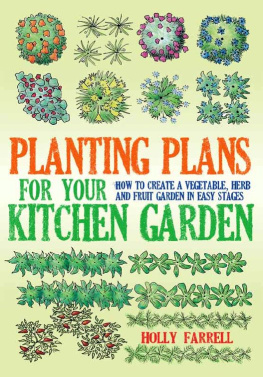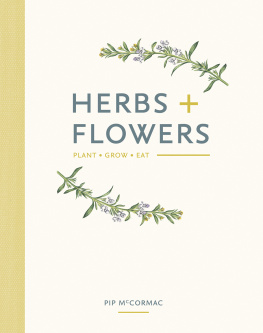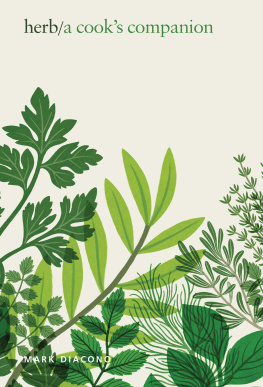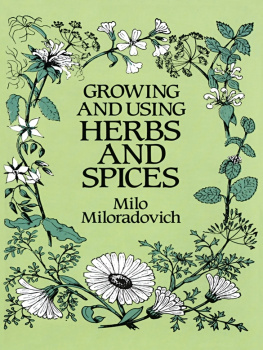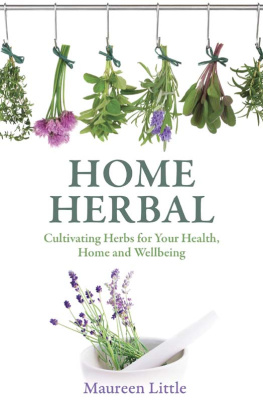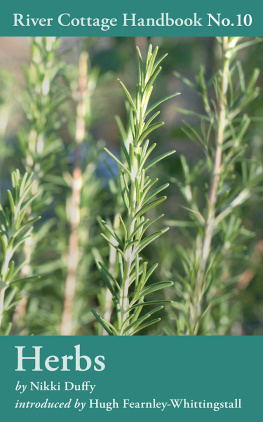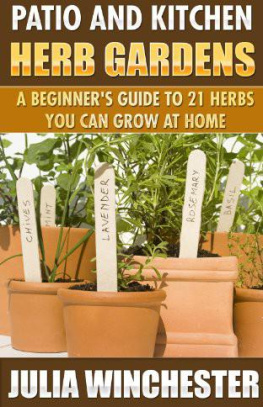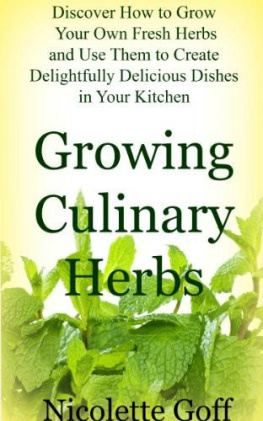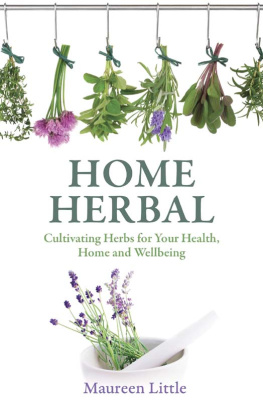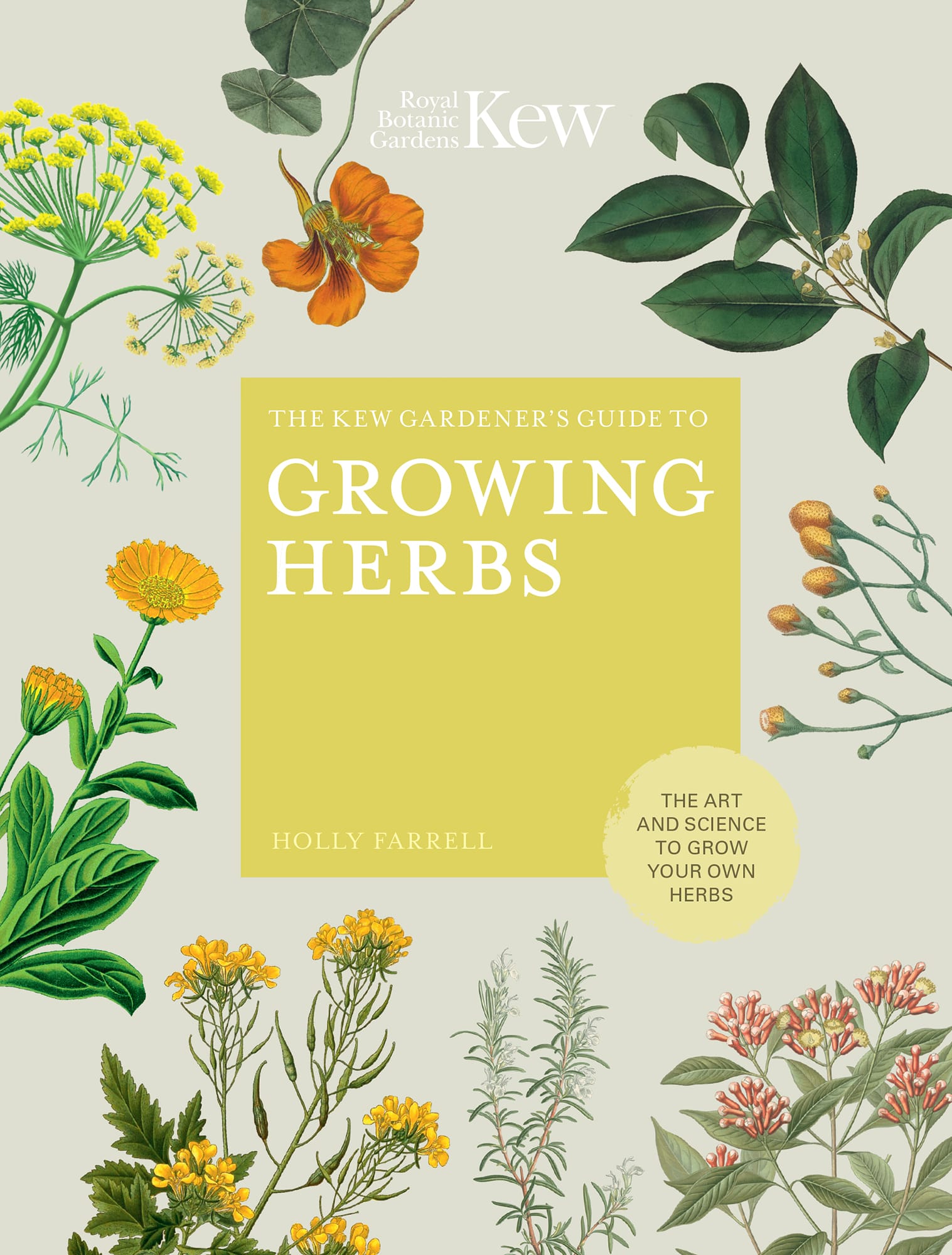
THE KEW GARDENERS GUIDE TO
GROWING HERBS
THE ART AND SCIENCE TO GROW YOUR OWN HERBS
HOLLY FARRELL

Introduction to growing herbs
INTRODUCTION
THE VALUE OF HERBS
The herbs in this book provide flavours and scents unlike any other: culinary herbs are a living trove of fresh flavours for any cook, with an almost alchemical power to transform the simplest dishes. Herbs can be used as seeds, flowers or leaves; be cooked and eaten; or be used to infuse a dish or drink. They are popping up in artisan gin, ice cubes and cocktail syrups and in foraged dishes and kitchen gardens of the best restaurants as chefs realize that often the only way to capture that elusive flavour is to have home-grown, freshly harvested herbs on their doorstep.
Since mans earliest forays into foraging and cultivating crops, herbs have been a vital part of our diet and economy. In addition to their myriad culinary applications, herbs have been used to dye cloth, heal the sick, perfume the body and home and even serve as money itself. Today, herbs form the basis (either naturally or chemically derived) of many medicines and remedies; are found in bouquets of cut flowers; are used in perfumes and dyes; and are invaluable plants for wildlife in the garden. In short, it is hard to think of a group of plants more useful to humankind than herbs and this is the definition of herbs that has been as applied to plants in this book.
Botanically, a herb is a plant that has fleshy rather than woody stems (hence herbaceous), but the range of plants that herbs include is far wider than that (although the more obvious food plants are excluded).
Many of the herbs historically used as medicine can be identified today using their Latin names the species name officinalis denotes that it was once used by the apothecaries, but modern-day pharmaceutical companies rely on herbs perhaps more than they would care to admit. Most people are aware of the sedative powers of the opium poppy (still a main source of morphine) and perhaps have heard of quinine (from the bark of the genus Cinchona, which was the first discovered cure for malaria), but what about Dioscorea, which allowed the development of many steroids and oral contraceptive drugs?
Herbs are around us all the time, and many gardens will already include some of them whose uses are known to the gardener and others that are not: this book can enlighten and provide suggestions for plants to include. For those without gardens already, growing herbs can become an addictive process. Start with the basic introductory pack of the main culinary herbs (basil, thyme, mint, rosemary) but go beyond these, be adventurous, and try growing something new herbs never disappoint.
HARDINESS ZONES
Each herb entry in this book has an associated hardiness zone rating. These ratings have been classified by the Royal Horticultural Society (RHS) to show how well a plant will grow in hot to freezing conditions. Plants in zones 12 will require frost-free conditions year-round; some will have even higher minimum temperatures. Plants that will survive a frost are in zones 3 and above, with higher zone numbers indicating a lower temperature below freezing that the plant will tolerate. Further details of the individual zones can be found on the RHS website (https://www.rhs.org.uk).
Herbs provide colour and form: here purple sage contrasts with golden marjoram.
MUST-HAVE HERBS
Every garden even if it is just a collection of pots on a windowsill can make space for a herb or two. This book details more than seventy of the most popular, invaluable and most easily grown herbs. How to choose between them depends on how they are to be used.
Herbs for cooks
Almost all herbs have some culinary application and there are many, many flavours to explore. These are a good starting point: rosemary, thyme, basil, chives, oregano, French tarragon, chillies, fennel, mint, parsley, sage, sorrel, savory, chicory and wild garlic.
Herbs for bakers
Among the most versatile are lemon verbena, thyme, rosemary, English lavender, angelica, mint, fennel, saffron, bay, cardamom, Carolina allspice, sweet Cicely, scented pelargoniums, elderflower, rose, sweet violet and ginger.
Herbs for drinks
Whether it is for tea or a tipple, these herbs are all good to infuse or make drinks. Try mint, lemon verbena, thyme, fennel, camomile, lemon balm, rose and elder. See also .
Herbs for crafters and florists
These flowers will all dry well, last as cut flowers or have a good scent: English mace, anise hyssop, lemon verbena, dill, lavender, bay, mint, rose, rosemary and feverfew. See also .
Herbs for wildlife
Almost all herbs are beloved by bees, butterflies and many other forms of garden wildlife: lavender, chives, fennel, lesser calamint, marigold, mint, hyssop, oregano, lemon balm, rose, elder, sweet violet, nasturtium and nettle.
Chive flowers are beloved by bees of all stripes.
EASY-CARE HERBS
Growing plants is a fairly straightforward process just give them light, water, nutrients and space to develop but some species are more finicky than others and for the novice grower it is best to start with hardy, reliable plants. Fortunately, many herbs are dependable garden stalwarts, so there are plenty to choose from.
Tips for success
Choose a plant suitable for the growing conditions available to it. Ensure the plant is also appropriate for the climate some herbs in this book are completely hardy, others are frost tender, and some need to be kept in warm conditions year-round. Humidity and light levels also need to be considered for some tropical plants.
Start with just one or two plants and grow a herb garden gradually so new plants always follow successes rather than over-ambitious failures.
Easy herbs for a windowsill pot
Try thyme, chillies, basil, mint, parsley and scented pelargonium.
Easy herbs for a large pot outside
Choose mint, oregano, thyme, rosemary, lavender, bay, nasturtium, marigold, sweet violet, chives, lemon verbena or parsley.
Easy herbs to plant in the ground
Plant chives, rosemary, lavender, bay, oregano, nasturtium, marigold, sweet violet, borage, fennel, lemon balm, sage, elder, nettle, thyme and sorrel.


